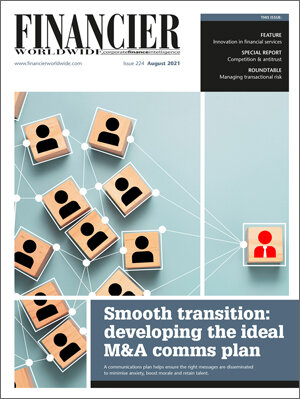NFTs – alternative asset of the future?
August 2021 | FEATURE | FINANCE & INVESTMENT
Financier Worldwide Magazine
Alternative assets continue to gain traction. Preqin forecasts that between the end of 2020 and the end of 2025, global alternative assets under management (AUM) are expected to increase by 60 percent, equal to a compound annual growth rate (CAGR) of 9.8 percent.
There are many reasons why alternative investments are increasing in popularity. Investors are burned out by market volatility, low interest rates are impacting returns, and technology-enabled platforms now grant individual investors access to alternative investments that were previously out of reach.
More than two in three high-net worth (HNW) investors, for example, plan to dedicate at least 10 percent of their portfolio to alternative assets, while 30 percent plan to increase their weighting over the next 12 months, according to Connection Capital.
Enter NFTs
In recent months, technology has been at the forefront of discussions around alternative assets, with the emergence of a new, highly sought-after form: the non-fungible token (NFT). NFTs represent the uniqueness of a digital asset, conveying ownership of a digital file (though the original creator may still retain copyright) by storing this data on a blockchain like Ethereum. NFTs are attractive because they come with the knowledge and reassurance, via the blockchain, that the NFT is the only ‘authentic’ one of its kind. As they cannot be altered or counterfeited, NFTs are intended to be a secure method of asset ownership, more easily transferable than traditional alternative assets.
The monthly volume of NFTs traded has exploded since September 2020, growing from a few million dollars to $241m in February 2021, according to NonFungible. In May, an estimated 85,787 NFTs were sold, at a total value of $5.8m a day, according to DappRadar. The trading volume of NFTs remained strong even as prices of virtually every crypto token on the market fell during May.
“Despite the bright start, some investors may, understandably, be reluctant to commit significant resources to a nascent asset class, the longevity of which is up for debate.”
A number of notable NFTs have been sold in recent months. In March, Jack Dorsey, the co-founder and chief executive of Twitter, sold his first tweet as an NFT for more than $2.9m. Also in March, an NFT by the artist Beeple became the most expensive NFT at auction, sold by Christie’s for over $60m.
Sotheby’s first NFT auction was in April, with digital works by the artist known as ‘Pak’ raising $16.8m. It sold an NFT of another piece of digital artwork, known as a ‘CryptoPunk’, for $11.8m. The auction house opened its first-ever virtual gallery this year, perhaps demonstrating the growing importance of digital sales.
In June, Sir Tim Berners-Lee announced he would be selling off the original code he used to create the modern internet as an NFT, with plans to use the proceeds to benefit causes he and his wife support.
The strong performance of the secondary market for NFTs also bodes well for the future of the asset class. According to Crypto Art, the secondary market drastically increased in size over the first half of 2021. A robust secondary market will be key to future of NFTs, providing liquidity and encouraging more artists and creators to get involved.
Risks and unknowns
Despite the bright start, some investors may, understandably, be reluctant to commit significant resources to a nascent asset class, the longevity of which is up for debate.
Of course, alternative investments, irrespective of whether they are digital or physical assets, typically represent a greater risk than mainstream investments. Blockchain-based assets may be even riskier, as their value can fluctuate wildly. NFTs also have a limited track record, of around two-years, on which to assess their performance. Another practical risk is losing access to a digital wallet, which could see an investor lose access to a particular asset.
NFTs are also subject to cyber threats. The momentum of the NFT ecosystem has already attracted hackers. In March, for example, cyber criminals compromised multiple Nifty Gateway NFT user accounts and were able to both transfer previously purchased NFTs from those accounts and purchase new ones to transfer using victims’ payment cards on file. NFT platforms can also be spoofed by malicious actors to steal user credentials or to implant malware. In response, investors need to take precautions to protect themselves and their assets, such as enabling multi-factor authentication (MFA) and unlinking wallets from the cloud.
As an entirely new type of unique asset, the scope and potential application of NFTs are seemingly limitless. But there are many unknowns. Is the market another bubble waiting to burst, or a solid investment option for years to come?
Like cryptocurrency and blockchain, the success or failure of the NFT market may come down to the extent to which it can be regulated.
© Financier Worldwide
BY
Richard Summerfield

